Concrete Perspective July-August 2017
Construction Sector
European Commission publishes LEVELs
On 25 August, the European Commission published the finalised framework for the assessment of the environmental performance of buildings, called LEVELs. Two finalised reports have been published on the DG Environment’s webpage for sustainable buildings:
http://ec.europa.eu/environment/eussd/buildings.htm
European Parliament’s resolution on industrial strategy
On 5 July, the European Parliament adopted a Joint motion for resolution on Building an ambitious EU industrial strategy as a strategic priority for growth, employment and innovation in Europe.
With the adoption of this Resolution, the European Parliament sent a strong sign of support the Joint Declaration signed by 130 signatories including BIBM.
Members of the European Parliament (MEPs) call on the Commission to “develop, by early 2018, together with the Member States, a Union strategy and an action plan for a consistent and comprehensive industrial policy aimed at Europe’s reindustrialisation, with targets, indicators, measures and time scales”.
Furthermore, on 11 July the delegation of the signatories met with Jerzy Buzek, the Chairman of the Committee for Industry, Research and Energy and they handed over the signed declaration. The delegation also met with the Estonian Minister of Economy on the same day.
Fire Safe Europe urges Commission to increase fire safety requirement in open letter
On 10 July 2017, Fire Safe Europe sent an open letter to President Juncker in which they called the Commission to act without further delay. The letter points out two important arguments of fire safety requirements.
First, it asks to develop a harmonised and rigorous performance based testing method for all facade systems.
Second, they call for a harmonized classification of the smoke toxicity of construction products.
The result of their campaign and open letter is that several media covered fire safety (Politico, The Economist, Reuters) and the European Parliament will discuss for the very first-time fire safety in buildings at a topical debate in the upcoming Plenary Session in Strasbourg (13 September), where both the Council of the EU and the European Commission have been requested to give statements.
Also, on 12 July, discussed fire safety in buildings as a special agenda item during its meeting in the Committee on the Internal Market and Consumer Protection (IMCO). The EP invited the European Commission (EC) to exchange views and to respond to questions from Members of the European Parliament.
MEP Catherine Stihler, the Vice-Chair of IMCO, emphasised on the need to have a European Fire Safety Strategy. She also called on the EU to put in place a system to classify smoke toxicity from different construction products used in buildings. She also said that she spoke to the Estonian presidency in the morning session about fire safety and will send a letter to the Estonian Presidency requesting to put the issue on the agenda of Member States in the Council of the EU.
MEP Christel Schaldemose highlighted the need to protect firefighters and citizens more at large, and was very supportive of improving fire safety at EU level. She inquired about the EC smoke toxicity study, and whether the EC will classify smoke toxicity.
Responding to MEPs quotations, Fulvia Raffaelli from DG GROW at the European Commission (EC), emphasised that this is a Member State issue. She said that the EC will create a platform for Members States and stakeholder to share best practices. She said the EC will look at the possibilities for fire safety strategy. She mentioned that the ongoing study on smoke toxicity will be published in autumn.
Furthermore, she emphasized that the current revision of the Energy Performance of Building Directive (EPBD) does not relate to fire safety and has no effect on the performance of facades at all (she firmly closed any request to include fire safety in the EPBD discussions).
At the end of the meeting, MEPs agreed that at this stage the EU must step up its act on the issue of fire safety. Also, they agreed to put more pressure on EU member states to reform fire safety regulations.
H2020 project iBROAD kicks off
The H2020 focuses on individual building renovation roadmaps kicked off on 3-4 July in Athene, Greece.
The project aims to explore, design, develop and demonstrate the concept of individual Building Renovation ROADmaps. The tool provides a customised renovation plan with a long-term horizon.
For more information, you can read here (BPIE).
Live from the European Union
Carcinogens and Mutagens Directive negotiations moved forward
On 11 July 2017, negotiators in the European Parliament and the EU Council of Ministers, reached agreement on stricter exposure limits to substances.
As for Respirable Crystalline Silica, the Directive in its Annex I “work involving exposure to respirable crystalline silica dust generated by a work process” and sets a Binding Occupational Exposure Limit Value (BOELV) of 0.1 mg/m³ for respirable crystalline silica.
Additionally, in the recitals part of the Directive, the NEPSI Social Dialogue Agreement is mentioned and recognised as a valuable tool to help to implement the Directive.
New limit values were confirmed for hardwood dust (2 mg/m3) and chromium VI (0,005 mg/m3) as well.
Another key provision and big step forward in the protection of workers relates to the medical follow-up after the exposure. National authorities will have to determine whether workers will continue to undergo health checks after the end of exposure “for as long as they consider it necessary”.
The Parliament and the Council will each vote on the draft directive after the summer break.
European Parliament– Press Release
European Commission – Press Release
Estonia takes over the Council’s rotating Presidency
On 1 July 2017, Estonia took over the rotating Presidency of the Council of the EU. Estonia is the first in the new Presidency Trio also including Bulgaria and Austria.
Trio Presidency has formulated five priority areas:
- A Union for Jobs, Growth and Competitiveness;
- A Union that empowers and protects all its citizens;
- Towards an energy union with a forward-looking climate policy;
- A union of freedom, security and justice;
- The union as a strong global actor.
In these areas, several initiatives can and possibly will affect the European Industry and the construction sector, namely
- the Energy and climate policy
- Union for jobs, growth and competitiveness.
The motto of the Presidency is ‘Unity through balance’, signifying that Europe has a lot of common grounds and it should tackle challenges together in a united manner.
The four priorities of the Estonian Presidency are:
- An open and innovative European economy
- A safe and secure Europe
- A digital Europe and the free movement of data
- An inclusive and sustainable Europe
Each of these priorities has a few topics that could impact our sector.
- An open and innovative European economy
The Estonian Presidency will concentre on the development of a business environment that favours stability, knowledge-based growth and competitiveness.
Ares to feature as a matter of priority:
- Value added tax regime for cross-border trade and removal of value added tax obstacles to e- commerce (2016/0370 CNS and 2016/0406 CNS)
- Cross-border company law
- New electricity market design
- HORIZON 2020
- A safe and secure Europe
The Presidency will be focusing on modern IT solutions and the introduction of databases to support the Schengen Area. These measures will affect constructively the European market by creating a safer environment.
- A digital Europe and the free movement of data
The digitalisation of the Single Market is the over-arching goal of the Estonian Presidency and of course it hides a lot of opportunities. The market will live up to its full potential, increasing competitiveness and creating a more favourable business environment.
Business Europe emphasised in its public letter to the Estonian Presidency, that a strong industrial strategy is particularly important in this context.
- An inclusive and sustainable Europe
Recent changes in the information society has changed the nature of employment; therefore, there is a need to pay more attention to working conditions and skills, as well as the need to reconcile work and family life.
From the point of sustainability, the Presidency is committed to the Paris Agreement and to the 40 % reduction in greenhouse gas emissions by 2030. Priority will be given to the following legislations in this context:
- Modernisation of EU Emissions Trading System (ETS) (2015/0148 COD)
- Effort-sharing regulation (ESR) (2016/0231 COD)
- Measures to limit greenhouse gas emissions from land use, land use change and forestry (LULUCF) (2016/0230 COD)
- Increasing energy efficiency (2016/0376 COD)
For further information: Estonian Presidency of the Council of EU – Priorities
National Award Winner Project
The content of this article is taken entirely from http://www.britishprecast.org/Awards/Best-Practice-Awards.aspx
British Precast Concrete Federation held its annual Best Practice Awards in last May. The awards are split into five categories: Innovation, Health and Safety, Project, Sustainability and Outstanding Contribution to Health and Safety.
Innovation award winner[1] – Marshalls, Keydrain
[1] The 2017 Innovation Award was sponsored by Chryso UK
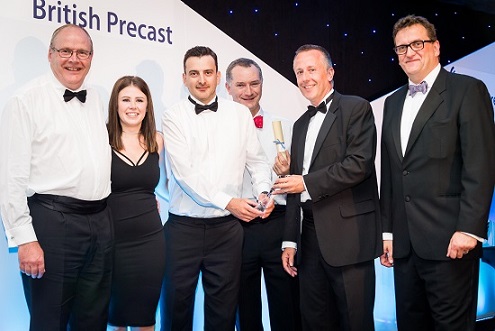
‘Keydrain’ is a single piece concrete drainage unit with a central core specifically designed to drain surface water away. Dual slots pressed into the surface of the unit transfer water to the core via a perpendicular slot at each end face when placed adjacent to one another. Any required length can be achieved by simply adding more units. The product enters an arena which is traditionally filled with non-concrete solutions such as linear channel systems with a plastic or steel grate. A key benefit of Keydrain is its aesthetic appeal as it is manufactured in a variety of concrete colours, which compliment the surrounding concrete or natural stone paving products. Additionally, the shape and weight of Keydrain enables simple installation.
Health and Safety award winner[1] (less than 250 employees) – Beresford’s Flooring
[1] The 2017 Health and Safety Award is sponsored by Forterra
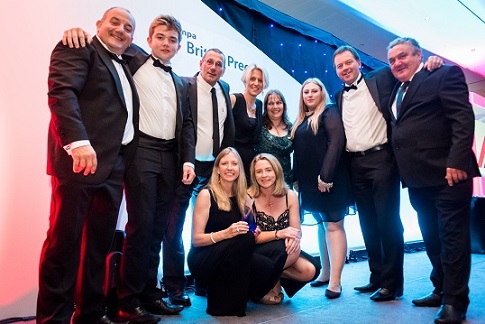
With a new lightweight system named ‘The Hole System’, a number of operations to the underside of Hollowcore floors can now be completed from ground level. This has reduced working at height, repetitive strain risks, exposure to dust and alkaline drilling wash water, and other risks associated with the regular assembly and moving of access equipment.
Health and Safety award winner (250 or more employees) – Brett Landscaping and Building Products

Creating a combined scrap handling system and improvements to the pallet transfer conveyor have drastically reduced gate access frequencies and exposures in both scrap and pallet areas for Fork lifts and personnel alike.
In addition, reduced manual handling and improved posture during work, with reductions in twisting and reaching, have also been recorded.
This award provides a mechanism for companies and the wider sector to celebrate the positive influence and impact that individuals and teams have made to create safer and healthier workplaces.
Project award winner[1] – Techrete
[1] The 2017 Project Award is sponsored by CARES
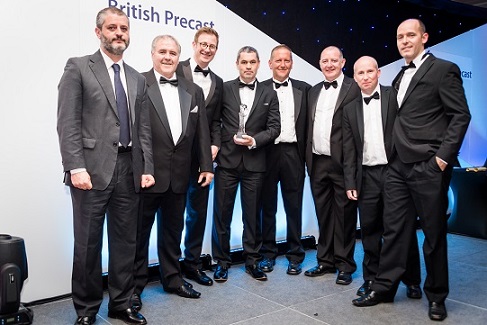
For the flagship John Lewis store in Leeds, the diagrid pattern was deconstructed by Techrete engineers to panelise a façade to enable production. Innumerable intricate details regarding the geometry, the engineering and the manufacturing were combined in 3D BIM, from which over 600 drawings were generated.
Many challenges were successfully overcome: accuracy of facetted corners, contrasting finishes within single units, installation of unusually shaped units of up to 14 tonnes in weight and the requirement for unique permanent fixing methods.
Precast concrete products are used for a wide range of applications in our built environment. This award showcases projects that deliver on aesthetics, functionality, innovation, workmanship, cost-effectiveness and demonstrates the inherent benefits and properties of precast concrete.
Sustainability award winner[1] – Forterra, Whittlesey Plant
[1] The 2017 Sustainability Award is sponsored by GCP
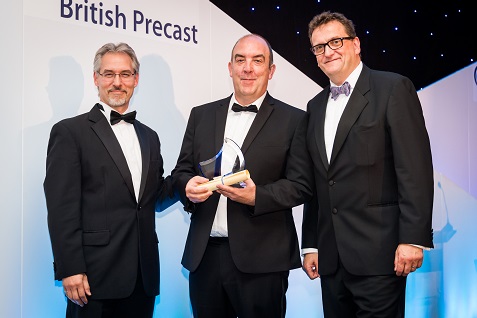
Forterra’s Whittlesey factory has been introducing measures to improve efficiency and reduce energy consumption over several years.
In 2016 the management team increased production by 12% while improving energy efficiency through a number of measures such as investing in new pallets, improved preventative maintenance programmes, loading shovel replacement, new burners, improved curing control systems and increased insulation.
This series of relatively small improvements have led to a saving in 2016 of 9% compared in energy consumption to 2015 and almost 18% when compared to 2014 when the project started.
This award rewards excellence within the British Precast membership and publicises the progress of the industry towards sustainability.
Outstanding Contribution to Health and Safety
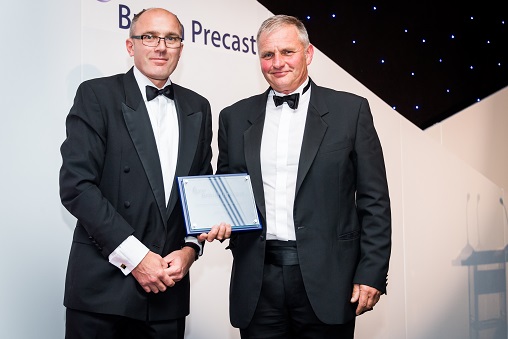
Chris Taylor from Stanton Bonna
This award is given to individuals and teams in recognition of leadership, special efforts, or significant contributions to improvements in health and safety in the business or along the supply chain.
Chris Taylor from Stanton Bonna, and Glenn Regan from Forticrete who win the award.
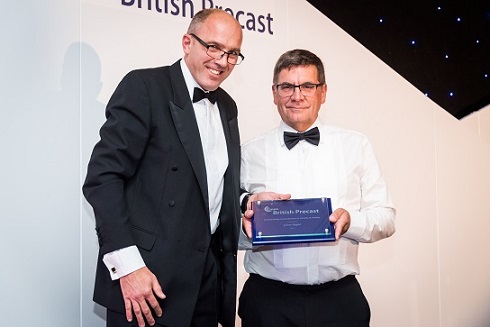
Glenn Regan from Forticrete
News in brief
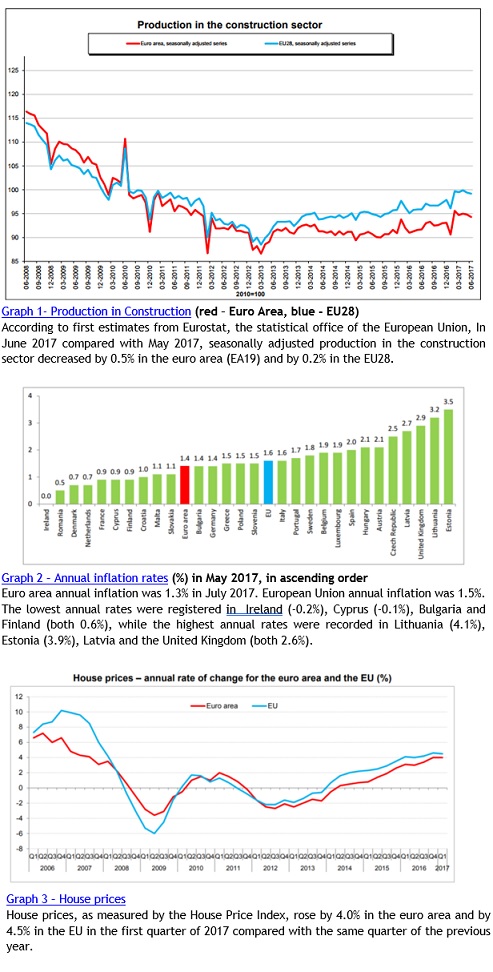
Agenda
SEPTEMBER 2017
05 September
CEN/TC 229/WG 4 Editorial Panel
Brussels, Belgium
08 September
ECP TF Fire and Eurocodes
Confcall
11 September
AhG Concrete Initiative
Brussels, Belgium
14 September
BIBM Technical Commission
Brussels, Belgium
25 September
Concrete Initiative on Energy Efficiency
Brussels, Belgium
OCTOBER 2017
04 October
CEN/TC 229/WG 4
Brussels, Belgium
04 October
Financing Sustainability (Concrete Initiative)
Brussels, Belgium
05 October
ECP TF Sustainable Concrete
Brussels, Belgium
09-10 October
CEN/TC 104/SC 1/TG 20
Paris, France
12 October
CPE Sustainability WG
Brussels, Belgium
12 October (tbc)
SG 13 Notified Bodies
Vienna, Austria
19 October
BIBM Communication Commission
Brussels, Belgium
24-25 October
VEEP General Assembly
Delft, The Netherlands
27 October
ECP Board
Brussels, Belgium
To the Newsletter of Construction Products Europe (former CEPMC), please follow this link.
To read the Newsletter of CEMBUREAU, please follow this link. You can also subscribe directly following this link http://www.cembureau.eu/newsletter/subscriptions.
To read the Quarterly Newsletter of The Concrete Initiative, please follow this link.
List of Acronyms:
CPE – Construction Product Europe
DG GROW – Directorate-General for Internal Market, Industry, Entrepreneurship and SMEs
ECP – European Concrete Platform
EMA – European Masonry Alliance
IPHA – International Pre-stressed Hollowcore Association
TF – Task Force
VEEP Project- Cost-Effective Recycling of CDW in High Added Value Energy Efficient Prefabricated Concrete Components for Massive Retrofitting of our Built Environment
